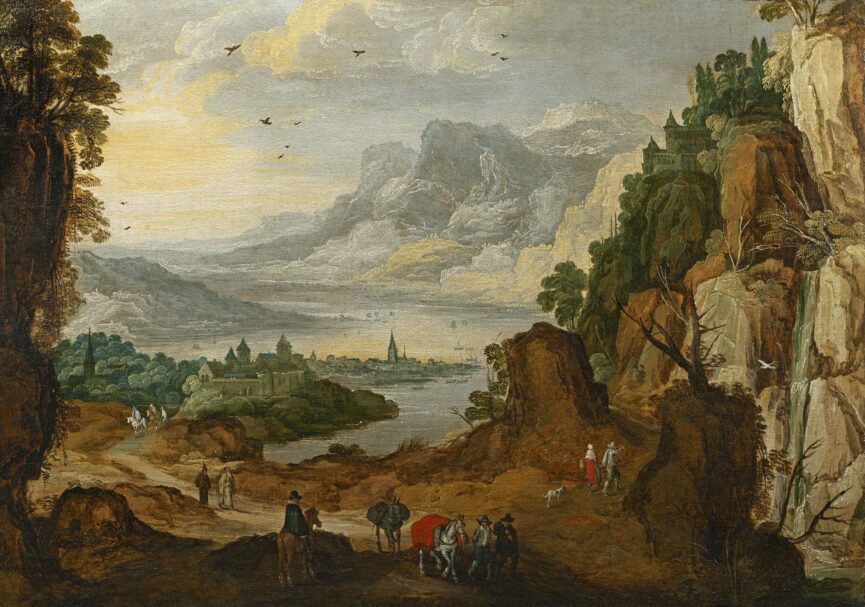JOSSE DE MOMPER and JAN BRUEGHEL THE YOUNGER
MOMPER Antwerp 1564 - 1635 BRUEGHEL Antwerp 1601 - 1678An extensive landscape, a fortified castle and town overlooking a lake and mountains beyond, steep rocks on either side and travellers in the foreground, including two monks
Oil on canvas: 86 x 121cm. 33 7/8 x 47 5/8 in.
In his expertise dated 4th.May 2017 Dr.Klaus Ertz has kindly confirmed he authorship of Josse de Momper for the landscape and Jan Brueghel the Younger for the figures. He points out that the condition of the painting is very good, and that the execution of the white clouds, rock edges and leaves of the trees is particularly sensitive.
He also notes that the high viewpoint and three colour planes – brown for the foreground, green for the middle distance and blue for the distance and the sky, speak for an early dating around 1620 – Momper’s best period of activity. In conclusion he remarks that the Brueghel, with Momper, created astonishing, integrated pictures which appear to be of one cast.
Dr.Ertz rightly seizes on the salient points of Momper’s landscape style, which derives from the weltanschauung of Joachim Patenir and Herri met de Bles, fused with the panoramic vision of Pieter Brueghel the Elder. Like Brueghel, it is now established that Momper visit- ed Italy, probably in the 1580’s (some frescoes by him have been identified in Rome), and that he would have witnessed first-hand the epic scenery of the Alps which is evoked so spectacularly in his landscapes. Our picture belongs to this category of the artist’s oeuvre from the early 1620’s when his viewpoint was still high, and the recession expressed by dif- fering valeurs, brown for the foreground, green for the middle distance and blue for the horizon. Later, and under the influence of the Dutch realist painters, Momper would lower the horizon, although still retaining the framing device of the high rocks, to create an almost theatrical mis-en-scene. Also evident here are the artist’s signature technique of nervous, jagged outlines to the mountains, and a dotted, almost pointillist treatment of the foliage, as well as impacted dots to describe the play of light on water. Few painters’ works are so im- mediately recognisable by the their individual execution. Jan Brueghel the Younger’s fi- nesse in adding characterful staffage to the scene is also evident, from the travellers leading their packhorses to the monks striding purposefully along the path.
The association between the Momper and Brueghel dynasties is well documented. The fami- lies shared an artistic friendship, and both Jan Brueghels, father and son, contributed figures to Momper’s landscapes. Their exact contribution has only recently been unravelled by Dr. Ertz, who has written catalogue raisonnes on both the Brueghel and De Momper. Other sig- nificant members of the Momper dynasty include his nephew Frans de Momper, Philip and Jan.
As the last representative of the world-view landscape Momper was enormously popular in his lifetime. He was patronised by the Governor of the Netherlands, Archduchess Isabella Clara Eugenia and was mentioned in Karel van Mander’s famous Schilderboeck, as well as having his portrait engraved by Van Dyck. It is significant that his traditional form of land- scape was still being practised in the 1620’s at a time when Van Goyen’s more realistic tonal approach was under way. This popularity is reflected by the fact that Momper’s work is represented in so many northern European museums, including at the Rijksmuseum, as well as the Prado.

